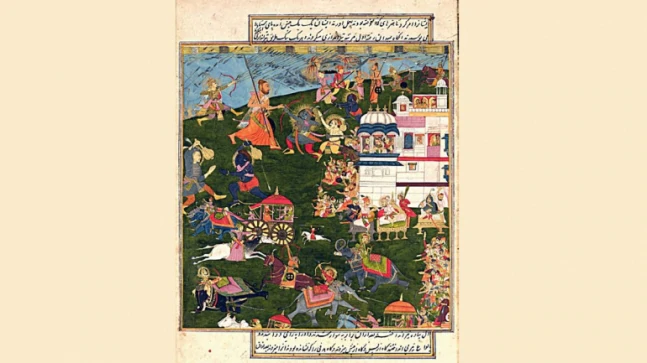
[ad_1]
The National Museum’s miniatures are now in augmented reality, on a screen near you.

A folio from the ‘Razmnama’, a Persian
translation of the Mahabharataa folio from the ‘Razmnama’, a Persian translation of the Mahabharata
If you’ve ever admired a miniature painting on a museum wall, you might know the feeling of wanting to hold it in your hands for a closer look. Life in Miniature partially fulfils that desire. The latest India-centric project by Google Arts and Culture makes over 1,000 miniatures, from the National Museum’s and 24 more collections available in gloriously high resolution. “These paintings were not meant to be viewed from behind glass. You now have an experience close to that of the original patrons,” says Kavita Singh, professor of art history at Delhi’s Jawaharlal Nehru University, who has also written an essay for the virtual show.
So, for instance, if you were to click on a painting of the Mughal emperor Akbar accompanying Tansen to meet the latter’s guru Swami Haridas in Vrindavan, the painting, at first glance, simply shows Tansen kneeling before his mentor, while the emperor stands behind him. Then you might notice Tansen’s tanpura, richly ornamented, sitting quietly by his side, while he looks reverently at the saint plucking his simple brown one. You’ll see three white-clad figures, but a closer look at their clothes reveals their social positions. The swami wears only a loincloth, while Tansen and Akbar wear jamas with a gold-edged sash. But then you might notice that Akbar is barefoot: perhaps in deference to Haridas?

Swami Haridasa with Tansen and Akbar at Vrindavana
The pleasure of these paintings extends beyond social analysis. As you zoom in, monkeys, squirrels and many birds become visible in the foliage. Google’s curators urge viewers to “find the parrots” or “spot the weapons”, and group images into “stories”, instead of the dryer chronological or geographical approaches. “A lot of older arcane scholarly work did not serve these paintings well. Narrative and thematic approaches are more prevalent now. This exhibition is rooted in visual delight, which was the intention of the painters,” says Singh. “Grouping images by subject or colour offers lively pathways into the art for people outside the academy. Perhaps the next step can be to make these resources available in other Indian languages. But this is a great start.”
[ad_2]
Source link